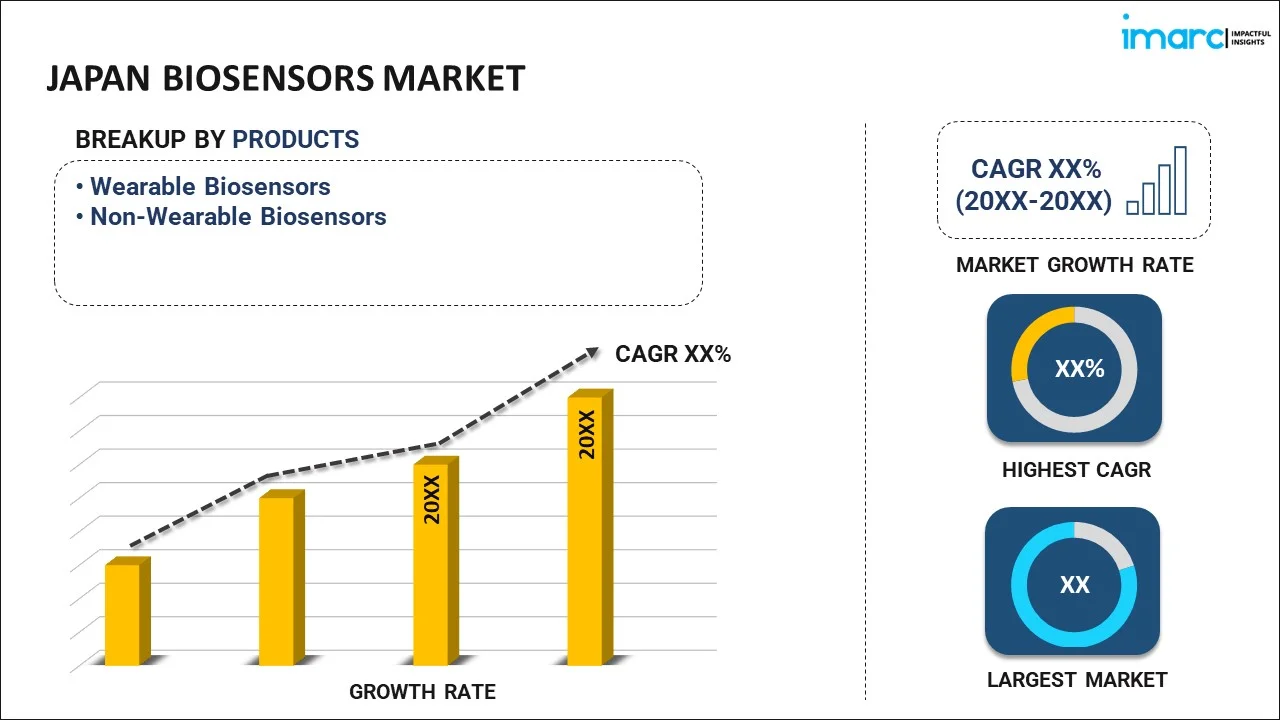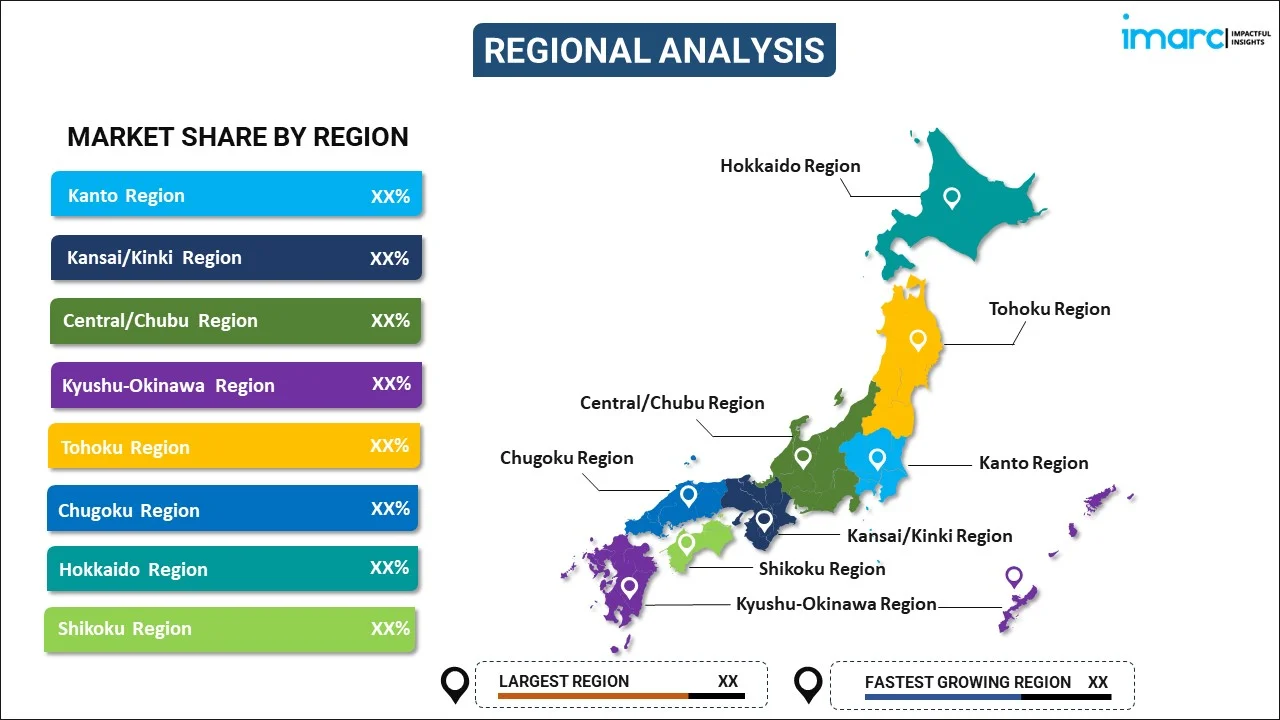
Japan Biosensors Market Report by Product (Wearable Biosensors, Non-Wearable Biosensors), Technology (Electrochemical Biosensors, Optical Biosensors, Piezoelectric Biosensors, Thermal Biosensors, Nanomechanical Biosensors, and Others), Application (Blood Glucose Testing, Cholesterol Testing, Blood Gas Analysis, Pregnancy Testing, Drug Discovery, Infectious Disease Testing, and Others), End User (Point of Care Testing, Home Healthcare Diagnostics, Research Laboratories, Security and Biodefense, and Others), and Region 2024-2032
Market Overview:
Japan biosensors market size is projected to exhibit a growth rate (CAGR) of 9.72% during 2024-2032. The expanding medical industry, along with the increasing adoption of nanotechnology-based biosensors, is primarily driving the market growth.
|
Report Attribute
|
Key Statistics
|
|---|---|
|
Base Year
|
2023 |
|
Forecast Years
|
2024-2032
|
|
Historical Years
|
2018-2023
|
| Market Growth Rate (2024-2032) | 9.72% |
A biosensor, often referred to as a biological sensor, is an analytical tool employed for the detection of alterations in diverse biological processes, which it then translates into an electrical signal. Biosensors find utility in monitoring a range of biological components, including enzymes, nucleic acids, tissues, cell receptors, microorganisms, and antibodies. They come in various types, including mass, optical, electrochemical, magnetic, nanomechanical, thermometric, acoustic, and immunosensors. Typically, a biosensor comprises key components such as a responsive sensor, transducer, microcontroller, signal conditioning circuit, and display unit. These devices are integrated into various applications, including resonant mirrors, chemical canaries, optodes, bio-computers, biochips, and glucometers. Biosensors have widespread applications, serving purposes such as point-of-care (POC) diagnostics, scientific research, environmental monitoring, and biodefense initiatives.
Japan Biosensors Market Trends:
The Japan biosensor market is witnessing a positive trajectory, with substantial growth driven by significant expansion in the global medical industry. Furthermore, the widespread adoption of wearable biosensors for continuous monitoring of vital signs among patients, infants, children, athletes, and fitness enthusiasts is a major catalyst for market growth. These biosensors enable remote monitoring and real-time transmission of biological data to healthcare professionals, a feature increasingly integrated into smart textiles for convenient vital sign tracking. The ongoing spread of the COVID-19 pandemic has further intensified the demand for biosensors in healthcare centers, facilitating continuous patient monitoring. Additionally, technological advancements such as the integration of connected devices with the Internet of Things (IoT) and the development of innovative nanotechnology-based biosensors are contributing to market growth. These advanced biosensors are employed in nanotubes, nanowires, nanorods, and nanoparticles for biomolecular detection. Other factors, including significant enhancements in healthcare infrastructure and extensive research and development (R&D) endeavors, are expected to propel the market forward.
Japan Biosensors Market Segmentation:
IMARC Group provides an analysis of the key trends in each segment of the market, along with forecasts at the country level for 2024-2032. Our report has categorized the market based on product, technology, application, and end user.
Product Insights:

- Wearable Biosensors
- Non-Wearable Biosensors
The report has provided a detailed breakup and analysis of the market based on the product. This includes wearable biosensors and non-wearable biosensors.
Technology Insights:
- Electrochemical Biosensors
- Optical Biosensors
- Piezoelectric Biosensors
- Thermal Biosensors
- Nanomechanical Biosensors
- Others
A detailed breakup and analysis of the market based on the technology have also been provided in the report. This includes electrochemical biosensors, optical biosensors, piezoelectric biosensors, thermal biosensors, nanomechanical biosensors, and others.
Application Insights:
- Blood Glucose Testing
- Cholesterol Testing
- Blood Gas Analysis
- Pregnancy Testing
- Drug Discovery
- Infectious Disease Testing
- Others
The report has provided a detailed breakup and analysis of the market based on the application. This includes blood glucose testing, cholesterol testing, blood gas analysis, pregnancy testing, drug discovery, infectious disease testing, and others.
End User Insights:
- Point of Care Testing
- Home Healthcare Diagnostics
- Research Laboratories
- Security and Biodefense
- Others
A detailed breakup and analysis of the market based on the end user have also been provided in the report. This includes point of care testing, home healthcare diagnostics, research laboratories, security and biodefense, and others.
Regional Insights:

- Kanto Region
- Kansai/Kinki Region
- Central/ Chubu Region
- Kyushu-Okinawa Region
- Tohoku Region
- Chugoku Region
- Hokkaido Region
- Shikoku Region
The report has also provided a comprehensive analysis of all the major regional markets, which include Kanto Region, Kansai/Kinki Region, Central/ Chubu Region, Kyushu-Okinawa Region, Tohoku Region, Chugoku Region, Hokkaido Region, and Shikoku Region.
Competitive Landscape:
The market research report has also provided a comprehensive analysis of the competitive landscape in the market. Competitive analysis such as market structure, key player positioning, top winning strategies, competitive dashboard, and company evaluation quadrant has been covered in the report. Also, detailed profiles of all major companies have been provided.
Japan Biosensors Market Report Coverage:
| Report Features | Details |
|---|---|
| Base Year of the Analysis | 2023 |
| Historical Period | 2018-2023 |
| Forecast Period | 2024-2032 |
| Units | US$ Million |
| Scope of the Report | Exploration of Historical Trends and Market Outlook, Industry Catalysts and Challenges, Segment-Wise Historical and Future Market Assessment:
|
| Products Covered | Wearable Biosensors, Non-Wearable Biosensors |
| Technologies Covered | Electrochemical Biosensors, Optical Biosensors, Piezoelectric Biosensors, Thermal Biosensors, Nanomechanical Biosensors, Others |
| Applications Covered | Blood Glucose Testing, Cholesterol Testing, Blood Gas Analysis, Pregnancy Testing, Drug Discovery, Infectious Disease Testing, Others |
| End Users Covered | Point of Care Testing, Home Healthcare Diagnostics, Research Laboratories, Security and Biodefense, Others |
| Regions Covered | Kanto Region, Kansai/Kinki Region, Central/ Chubu Region, Kyushu-Okinawa Region, Tohoku Region, Chugoku Region, Hokkaido Region, Shikoku Region |
| Customization Scope | 10% Free Customization |
| Report Price and Purchase Option | Single User License: US$ 3699 Five User License: US$ 4699 Corporate License: US$ 5699 |
| Post-Sale Analyst Support | 10-12 Weeks |
| Delivery Format | PDF and Excel through Email (We can also provide the editable version of the report in PPT/Word format on special request) |
Key Questions Answered in This Report:
- How has the Japan biosensors market performed so far and how will it perform in the coming years?
- What has been the impact of COVID-19 on the Japan biosensors market?
- What is the breakup of the Japan biosensors market on the basis of product?
- What is the breakup of the Japan biosensors market on the basis of technology?
- What is the breakup of the Japan biosensors market on the basis of application?
- What is the breakup of the Japan biosensors market on the basis of end user?
- What are the various stages in the value chain of the Japan biosensors market?
- What are the key driving factors and challenges in the Japan biosensors?
- What is the structure of the Japan biosensors market and who are the key players?
- What is the degree of competition in the Japan biosensors market?
Key Benefits for Stakeholders:
- IMARC’s industry report offers a comprehensive quantitative analysis of various market segments, historical and current market trends, market forecasts, and dynamics of the Japan biosensors market from 2018-2032.
- The research report provides the latest information on the market drivers, challenges, and opportunities in the Japan biosensors market.
- Porter's five forces analysis assist stakeholders in assessing the impact of new entrants, competitive rivalry, supplier power, buyer power, and the threat of substitution. It helps stakeholders to analyze the level of competition within the Japan biosensors industry and its attractiveness.
- Competitive landscape allows stakeholders to understand their competitive environment and provides an insight into the current positions of key players in the market.
Need more help?
- Speak to our experienced analysts for insights on the current market scenarios.
- Include additional segments and countries to customize the report as per your requirement.
- Gain an unparalleled competitive advantage in your domain by understanding how to utilize the report and positively impacting your operations and revenue.
- For further assistance, please connect with our analysts.
 Inquire Before Buying
Inquire Before Buying
 Speak to an Analyst
Speak to an Analyst
 Request Brochure
Request Brochure
 Request Customization
Request Customization




.webp)




.webp)












